International Journal of Image, Graphics and Signal Processing @ijigsp
Статьи журнала - International Journal of Image, Graphics and Signal Processing
Все статьи: 1157
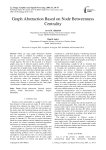
Graph Abstraction Based on Node Betweenness Centrality
Статья научная
There are many graph abstraction methods that are existed as solutions for problems of graphs visualization. Visualization problems include edge crossings and node occlusions that hide the potential existed patterns. The aim of this research is to abstract graphs using one of network analysis metrics which is node betweenness centrality. Betweenness centrality is calculated for all graph nodes. Graph abstraction is done by removing the nodes with their attached edges such that they have betweenness centrality lower than a certain examined threshold. Experiments have been conducted and results show that the proposed abstraction method can effectively reduce the complexity of the graph visualization in term of node degree. Modularity of clusters after filtering is decreased but the final graph visualization is simpler and more informative.
Бесплатно
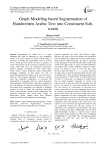
Graph Modeling based Segmentation of Handwritten Arabic Text into Constituent Sub-words
Статья научная
Segmentation of Arabic text is a major challenge that shall be addressed by any recognition system. The cursive nature of Arabic writing makes it necessary to handle the segmentation issue at various levels. Arabic text line can be viewed as a sequence of words which in turn can be viewed as a sequence of sub-words. Sub-words have the frequently encountered intrinsic property of sharing the same vertical space which makes vertical projection based segmentation technique inefficient. In this paper, the task of segmenting handwritten Arabic text at sub-word level is taken up. The proposed algorithm is based on pulling away the connected components to overcome the impossibility of separating them by vertical projection based approach. Graph theoretic modeling is proposed to solve the problem of connected component extraction. In the sequel, these components are subjected to thorough analysis in order to obtain the constituent sub-words where a sub-word may consist of many components. The proposed algorithm was tested using variety of handwritten Arabic samples taken from different databases and the results obtained are encouraging.
Бесплатно
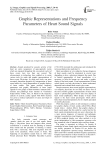
Graphic representations and frequency parameters of heart sound signals
Статья научная
Sounds produced by acoustic activity of the heart are series (sequences) of quasi-periodic events which are repeated throughout life, one period (cycle) of these events lasts less than one second. The advancements in technology have enabled us to create various tools for audio and graphic representations of these events. Physicians, by using such tools, can more accurately determine diagnosis by interpretation of heart sound and/or by visual interpretation of graphic displays of heart sounds. This paper presents frequency parameters and graphic illustrations of heart sound signals for two groups of heart murmurs: innocent Still’s murmur and pathologic heart murmur of Ventricular Septal Defect (VSD). Also, on behalf of the frequency analysis of acoustic cardiac signals with Still’s murmur was given a medical explanation of cause and origin of Still’s murmur.
Бесплатно
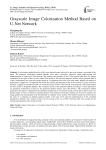
Grayscale Image Colorization Method Based on U-Net Network
Статья научная
A colorization method based on a fully convolutional neural network for grayscale images is presented in this paper. The proposed colorization method includes color space conversion, grayscale image preprocessing and implementation of improved U-Net network. The training and operating of the U-Net network take place for images represented in the space of the Lab color model. The trained U-Net network integrates realistic colors (generate data of a and b components) into grayscale images based on L-component data of the Lab color model. Median cut method of quantization is applied to L-component data before the training and operating of the U-Net network. Logistic activation function is applied to normalized results of convolution layers of the U-Net network. The proposed colorization method has been tested on ImageNet database. The evaluation results of the proposed method according to various parameters are presented. Colorization accuracy by the proposed method reachers more than 84.81%. The colorization method proposed in this paper is characterized by optimized architecture of convolution neural network that is able to train on a limited image set with a satisfactory training duration. The proposed colorization method can be used to improve the image quality and restoring data in the development of computer vision systems. The further research can be focused on the study of a technique of defining optimal number of the gray levels and the implementation of the combined quantization methods. Also, further research can be focused on the use of HSV, HLS and other color models for the training and operating of the neural network.
Бесплатно
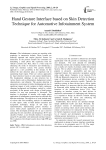
Hand gesture interface based on skin detection technique for automotive infotainment system
Статья научная
The infotainment systems are acquiring wide popularity in automotive domain. These systems are manually operated and require physical contact for interaction. In the present scenario the consumers are demanding a smart phone like experience from the vehicle’s console unit. Thus, there is a wide scope for enhancing the mode of interaction and introducing a touch less interface system. The gesture interface approach is a new possibility in this domain. In this method the skin detection plays an important role in segmenting hand region. There are various approaches for hand detection based on skin region identification. The fundamental challenge in skin detection lies in various factors such as illumination, background, camera characteristics, and ethnicity. The gesture detection in automotive environment is further challenging task due to significant impact of wide variation in light, continuous changing background and hindrance caused by vehicle movement. In the present work, design of hand gesture interface for rear seat passenger is discussed. The interface is developed to interact with media player application of infotainment system based on efficient skin detection technique. The objectives of work include study of various skin color modeling, analysis of combination of color spaces, study of hand feature extraction and recognition techniques, design of lab setup for experimentation, implementing gesture interface to access media player application of an infotainment system. The developed prototype lab set up is used for analyzing the skin classifiers and designing a Hi-Vi skin classifier. Further, a user friendly interface is developed using Hi-Vi algorithm with multimode interface features. The evaluation of developed system shows high TPR and low FPR.
Бесплатно
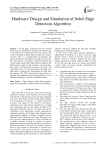
Hardware Design and Simulation of Sobel Edge Detection Algorithm
Статья научная
In this paper, a hardware system for Sobel Edge Detection Algorithm is designed and simulated for a 128 pixel, 8-bit monochrome line-scan camera. The system is designed to detect objects as they move along a conveyor belt in a manufacturing environment, the camera will observe dark objects on a light conveyor belt. The edge detector is required to detect horizontal and vertical edges using Sobel edge detection method. The Sobel operator requires 3 lines and takes 3 pixels per line, thus using a 3×3 input block to process each pixel. The centre pixel of the 3×3 pixel block can be classified as an edge point or otherwise by thresholding the value from the operator. The FPGA based Sobel edge detector is designed and simulated using Altera Quartus II 8.1 web edition by targeting Cyclone II development boards.
Бесплатно
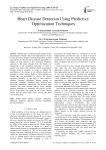
Heart disease detection using predictive optimization techniques
Статья научная
Health care is a major research domain needed instantaneous solutions. Due to the digitalization of data in each and every domain it is becoming tedious to store and analysis. So, the demand of proficient algorithms for health care data analysis is also increasing. Predictive analytics is the major demand from the health care community to the computing researches in order to predict and reduce the potential health catastrophes. Parallel research attempts are made to predict the possibilities of the disease on the different health care domains at various regions. However, those attempts are limited and not remarkable to achieve the desired outcomes. Recently, in the field of data analytics; Machine Learning techniques became popular in generating optimized solutions with effective data processing capabilities. Henceforth, this research work considers the heart disease analysis using machine learning techniques to determine the disease severity levels. Experiments are made on UCI heart disease dataset and our results shows 92% accuracy the heart severity detection.
Бесплатно

Herbs Recognition Based on Android using OpenCV
Статья научная
Herbs are used in traditional medicine. There are so many herbs are spread across the world, it is difficult to memorize it all. This paper describes an android application to recognize herbs by their leaf characteristics (shape, veins, and keypoints). Shape and veins of leaves are recognized by Invariant Moment Method as the feature extraction. City Block Distance used to calculate the distance between the features. Whereas for detection and keypoints extraction using Oriented FAST and Rotated BRIEF on OpenCV library. This keypoints distance calculation using Brute-Force Hamming. Matching is done by calculating the shortest distance between test image and reference image. If the result is less than or equal to threshold then image is match. Experiment result show this application can achieve 79% of success rate by using keypoints. This result is influenced by glossy leaf surface, so there is many reflected light that become noise.
Бесплатно
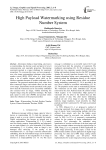
High Payload Watermarking using Residue Number System
Статья научная
Information hiding or data hiding, also known as watermarking, has become a part and parcel of covert communication and copyright protection. Maximizing watermark payload is a major challenge for watermark researchers. To overcome this issue, we have proposed a new color image watermarking technique, using residue number system (RNS). RNS refers to a large integer using a set of smaller integers which relies on the Chinese remainder theorem of modular arithmetic for its operation. The proposed method takes pixel values from three watermark images and embeds them into the main cover image. Experimental results presented in this paper shows that the watermark can be successfully embedded and extracted from an image, without distorting the original image using the proposed technique. The high peak signal to noise ratio (PSNR) and payload values claims the robustness of the proposed method.
Бесплатно
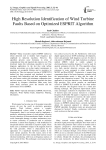
High Resolution Identification of Wind Turbine Faults Based on Optimized ESPRIT Algorithm
Статья научная
Many researchers employ ESPRIT method as robust detection tool to identify fault frequency and amplitude in induction machines. However, this algorithm presents some limitation in terms of computational time and required data memory size. This drawback makes this technology unusable in real time diagnosis application. In the fact that wind turbine machine necessitates an on-line regular maintenance to guarantee an acceptable lifetime and to maximize its productivity. Thus, an improved version of ESPRIT-TLS method has been proposed and simulated to extract accurately fault frequencies and their magnitudes from the wind stator current with minimum computation time and less memory cost. The proposed approach has been evaluated by computer simulations under many fault kinds. Study outcomes prove the benefits and the performance of Fast-ESPRIT.
Бесплатно
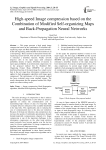
Статья научная
This paper presents a high speed image compression based on the combination of modified self-organizing maps and Back-Propagation neural networks. In the self-organizing model number of the neurons are in a flat topology. These neurons in interaction formed self-organizing neural network. The task this neural network is estimated a distribute function. Finally network disperses cells in the input space until estimated probability density of inputs. Distribute of neurons in input space probability is an information compression. So in the proposed method first by Modified Self-Organizing Feature Maps (MSOFM) we achieved distributed function of the input image by a weight vector then in the next stage these information compressed are applied to back-propagation algorithm until image again compressed. The performance of the proposed method has been evaluated using some standard images. The results demonstrate that the proposed method has High-speed over other existing works.
Бесплатно
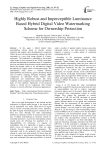
Статья научная
In this paper a hybrid digital video watermarking scheme based on discrete wavelet transform and singular value decomposition is proposed. Unlike the most existing watermarking schemes, the used watermark is a gray scale image instead of a binary watermark. The watermark is embedded in the original video frames by first converted it into YCbCr color space and than decomposing the luminance part (Y component) into four sub-bands using discrete wavelet transform and finally the singular values of LL sub-band are shaped perceptually by singular values of watermark image. The experimental result shows a tradeoff between imperceptibility and resiliency against intentional attacks such as rotation, cropping, histogram stretching, JPEG compression on individual frames, Indeo5 video compression and unintentional attacks like frame swapping, frame averaging, frame insertion and different types of noise addition. Superiority of the proposed scheme is carried out by comparison with existing schemes to reveal its efficiency for practical applications.
Бесплатно
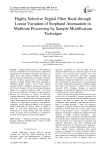
Статья научная
Digital spectral analysis is the significant factor of consideration by which numerous applications importantly need of effective reception and analysis of signals, that is, the reception of signals is needed with improved spectral characteristics and simple techniques. To meet the above requirements, a novel technique is proposed in digital bandpass filter bank, supported by 'Modified Kaiser window' based Finite impulse response method in Multirate processing followed by Fast Fourier transform. The novel technique influences largely in the proposed method in such a way that it involves the modification of samples of input signal for deriving the advantages in respect of selectivity, stopband attenuation, peak output and constant width cum sharp rise of response apart from smooth spectral output when compared with existing methods. Further, reduction in computational complexity and hardware complexity are the additional features of the proposed method, henceforth; its spectral output is suitable in many of real time applications and moreover advantageous in digital hearing aids. The simulation results are drawn and its performance is compared to elucidate the advantages in the proposed method.
Бесплатно

Histogram Bins Matching Approach for CBIR Based on Linear grouping for Dimensionality Reduction
Статья научная
This paper describes the histogram bins matching approach for CBIR. Histogram bins are reduced from 256 to 32 and 16 by linear grouping and effect of this dimensionality reduction is analyzed, compared, and evaluated. Work presented in this paper contributes in all three main phases of CBIR that are feature extraction, similarity matching and performance evaluation. Feature extraction explores the idea of histogram bins matching for three colors R, G and B. Histogram bin contents are used to represent the feature vector in three forms. First form of feature is count of pixels, and then other forms are obtained by computing the total and mean of intensities for the pixels falling in each of the histogram bins. Initially the size of the feature vector is 256 components as histogram with the all 256 bins. Further the size of the feature vector is reduced to 32 bins and then 16 bins by simple linear grouping of the bins. Feature extraction processes for each size and type of the feature vector is executed over the database of 2000 BMP images having 20 different classes. It prepares the feature vector databases as preprocessing part of this work. Similarity matching between query and database image feature vectors is carried out by means of first five orders of Minkowski distance and also with the cosine correlation distance. Same set of 200 query images are executed for all types of feature vector and for all similarity measures. Performance of all aspects addressed in this paper are evaluated using three parameters PRCP (Precision Recall Cross over Point), LS (longest string), LSRR (Length of String to Retrieve all Relevant images).
Бесплатно
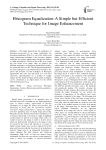
Histogram Equalization-A Simple but Efficient Technique for Image Enhancement
Статья научная
This paper demonstrates the significance of histogram processing of an image particularly the histogram equalization (HE). It is one of the widely used image enhancement technique. It has become a popular technique for contrast enhancement because the method is simple and effective. The basic idea of HE is to re-map the gray levels of an image. Here we propose two different techniques of Histogram Equalization namely, the global HE and local HE. The Histogram Equalization has been performed in the MATLAB environment. The merits and demerits of both techniques of Histogram Equalization have also been discussed. It is seen after exhaustive experimentation on a number of sample images that the proposed image enhancement techniques can be considered as an improvement over the inbuilt MATLAB function histeq.
Бесплатно

Статья научная
Face recognition is one of the conventional problems in computer vision. Its recognition rate falls steeply when the images are captured in an unconstrained environment. One of the fundamental issues that creep into unconstrained environment capturing is that of the face pose variation. Due to face pose variation, occlusion of crucial features takes place. Occlusion may lead to information loss in the face descriptor which describes the face appearance. In this paper, we propose learning-based descriptor that combines horizontal, vertical and diagonal pattern of blocks generated from the convolution of face image with Gabor filter bank. To use only discriminative features, Probabilistic Linear Discriminant Analysis (PLDA) is used. The fusion of non-uniform texture based descriptor along with the PLDA approach aids in retaining enough of discriminative information to overcome the information loss occurring during feature occlusion. Since HVDGBP face descriptor utilizes the fundamental concept of Linear Binary Pattern (LBP) henceforth it helped in meeting low processing demands and ease of computing characteristic required for good face descriptors. Comprehensive comparative performance analysis of the robustness of the proposed face descriptor to withstand pose variations is presented. UMIST and AT&T Database is used for experimental analysis.
Бесплатно
Human Abnormal Activity Recognition from Video Using Motion Tracking
Статья научная
The detection of violent behavior in the public environment using video content has become increasingly important in recent years due to the rise of violent incidents and the ease of sharing and disseminating video content through social media platforms. Efficient and effective techniques for detecting violent behavior in video content can assist authorities with identifying potential hazards, preventing crimes, and promoting public safety. Violence detection can also help to mitigate the psychological damage caused by viewing violent content, particularly in vulnerable populations such as infants and victims of violence. We have proposed an algorithm to calculate new descriptors using the magnitude and orientation of optical flow (MOOF) in the video. Descriptors are extracted from MOOF based on four binary histograms each by applying various weighted thresholds. These descriptors are used to train Support Vector Machine (SVM) and classify the video as violent or nonviolent. The proposed algorithm has been tested on the publicly available Hockey Fight Dataset and Violent Flow dataset. The results demonstrate that the proposed descriptors outperform the state-of-the-art algorithms with an accuracy of 91.5% and 78.5% on the Hockey Fight and Violent Flow datasets, respectively.
Бесплатно
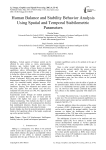
Human Balance and Stability Behavior Analysis Using Spatial and Temporal Stabilometric Parameters
Статья научная
Certain aspects of balance control can be affected by some entries as vision, proprioception, direction, age, Gender, height and weight. The knowledge of the effects of these factors on postural equilibrium allows differentiating pathological and physiological postural aspects. The aim of this study is to define the effects of these entries on postural control by analyzing the parameters: mean velocity of CoP (center of pressure), RMS (root mean square) CoP of displacement, Range of COP, CEA (confidence ellipse area). We examined healthy subjects between 19-42 years of age during the quiet stance under static conditions: keeping foot outspread and opened eyes (PE_YO), tighten foot and opened eyes (PS_YO), outspread foot and closed eyes (PE_YF), tightened foot and closed eyes (PS_YF). Experimental results through all studied parameters permit to conclude that the lack of vision and the situation with tighten foot cause a degradation of balance maintaining. They indicate also that it is easier to maintain equilibrium on the anteroposterior direction than mediolateral direction. Results show also a less well-controlled posture for male related to female. Results display also that the postural parameters studied failed to find significant effect of the height, weight and age on the postural stability.
Бесплатно
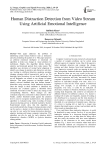
Human Distraction Detection from Video Stream Using Artificial Emotional Intelligence
Статья научная
This paper addresses the problem of identifying certain human behavior such as distraction and also predicting the pattern of it. This paper proposes an artificial emotional intelligent or emotional AI algorithm to detect any change in visual attention for individuals. Simply, this algorithm detects human’s attentive and distracted periods from video stream. The algorithm uses deviation of normal facial alignment to identify any change in attentive and distractive activities, e.g., looking to a different direction, speaking, yawning, sleeping, attention deficit hyperactivity and so on. For detecting facial deviation we use facial landmarks but, not all landmarks are related to any change in human behavior. This paper proposes an attribute model to identify relevant attributes that best defines human’s distraction using necessary facial landmark deviations. Once the change in those attributes is identified, the deviations are evaluated against a threshold based emotional AI model in order to detect any change in the corresponding behavior. These changes are then evaluated using time constraints to detect attention levels. Finally, another threshold model against the attention level is used to recognize inattentiveness. Our proposed algorithm is evaluated using video recording of human classroom learning activity to identify inattentive learners. Experimental results show that this algorithm can successfully identify the change in human attention which can be used as a learner or driver distraction detector. It can also be very useful for human distraction detection, adaptive learning and human computer interaction. This algorithm can also be used for early attention deficit hyperactivity disorder (ADHD) or dyslexia detection among patients.
Бесплатно
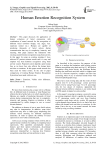
Human Emotion Recognition System
Статья научная
This paper discusses the application of feature extraction of facial expressions with combination of neural network for the recognition of different facial emotions (happy, sad, angry, fear, surprised, neutral etc..). Humans are capable of producing thousands of facial actions during communication that vary in complexity, intensity, and meaning. This paper analyses the limitations with existing system Emotion recognition using brain activity. In this paper by using an existing simulator I have achieved 97 percent accurate results and it is easy and simplest way than Emotion recognition using brain activity system. Purposed system depends upon human face as we know face also reflects the human brain activities or emotions. In this paper neural network has been used for better results. In the end of paper comparisons of existing Human Emotion Recognition System has been made with new one.
Бесплатно

